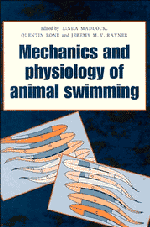Book contents
- Frontmatter
- Contents
- Contributors
- Introduction
- 1 Functional patterns of swimming bacteria
- 2 Buoyancy and swimming in marine planktonic protists
- 3 The role of fins in the competition between squid and fish
- 4 The biology of fish swimming
- 5 Swimming physiology of pelagic fishes
- 6 The mechanical design of the fish muscular system
- 7 How do fish use their myotomal muscle to swim? In vitro simulations of in vivo activity patterns
- 8 The timing of lateral muscle strain and EMG activity in different species of steadily swimming fish
- 9 Swimming in the lamprey: modelling the neural pattern generation, the body dynamics and the fluid mechanics
- 10 Swimming capabilities of Mesozoic marine reptiles: a review
- 11 Stone, bone or blubber? Buoyancy control strategies in aquatic tetrapods
- 12 Functional anatomy of the ‘flight’ apparatus in penguins
- 13 Energy conservation by formation swimming: metabolic evidence from ducklings
- Bibliography
- Index
2 - Buoyancy and swimming in marine planktonic protists
Published online by Cambridge University Press: 05 March 2012
- Frontmatter
- Contents
- Contributors
- Introduction
- 1 Functional patterns of swimming bacteria
- 2 Buoyancy and swimming in marine planktonic protists
- 3 The role of fins in the competition between squid and fish
- 4 The biology of fish swimming
- 5 Swimming physiology of pelagic fishes
- 6 The mechanical design of the fish muscular system
- 7 How do fish use their myotomal muscle to swim? In vitro simulations of in vivo activity patterns
- 8 The timing of lateral muscle strain and EMG activity in different species of steadily swimming fish
- 9 Swimming in the lamprey: modelling the neural pattern generation, the body dynamics and the fluid mechanics
- 10 Swimming capabilities of Mesozoic marine reptiles: a review
- 11 Stone, bone or blubber? Buoyancy control strategies in aquatic tetrapods
- 12 Functional anatomy of the ‘flight’ apparatus in penguins
- 13 Energy conservation by formation swimming: metabolic evidence from ducklings
- Bibliography
- Index
Summary
This chapter reviews some adaptative systems of buoyancy regulation and active swimming used by marine planktonic protists to maintain position. Collective dynamics existing in experimental conditions and concentrating phenomena in natural conditions are not examined.
INTRODUCTION
Protists are predatory or photosynthetic single-celled eukaryotes (in the nanometre to millimetre range) that have physiological capabilities comparable to those in metazoans where they are distributed amongst specialized cells. Since the protists have colonized solid and fluid environments, they exhibit a wide range of behavioural patterns. To some extent pelagic species compensate for the tendency to sink by using regulatory buoyancy mechanisms. They are also capable of responding to external factors and physical parameters by adjusting their movements and swimming behaviour. The physiological activities involved in buoyancy regulation and generation of coordinated movements use a complex system of protein filaments, the so-called cytoskeleton, that extend throughout the cytoplasm (actin, microtubules, non-actin nanofilaments and their associated proteins) and a sophisticated machinery involving signalling molecules, cell-surface receptors, motor molecules and ions (Amos & Amos, 1991).
The present chapter reviews adaptations of individual cells and colonial forms of marine planktonic protists to buoyancy and swimming. The environmental factors guiding the generation of concentration/convection patterns and the collective dynamics of micro-organisms that have recently been reviewed are not described here (Kessler, 1985,1989; Levandowsky & Kaneta, 1987).
- Type
- Chapter
- Information
- The Mechanics and Physiology of Animal Swimming , pp. 13 - 26Publisher: Cambridge University PressPrint publication year: 1994
- 5
- Cited by



